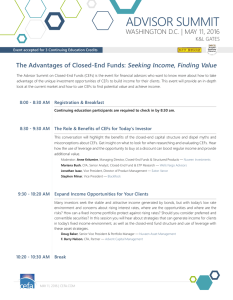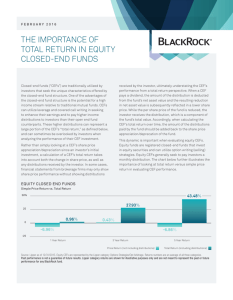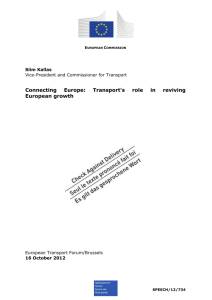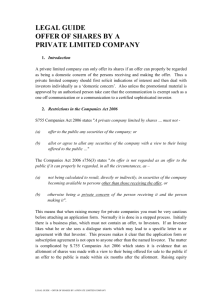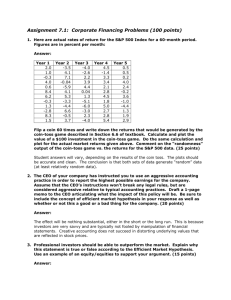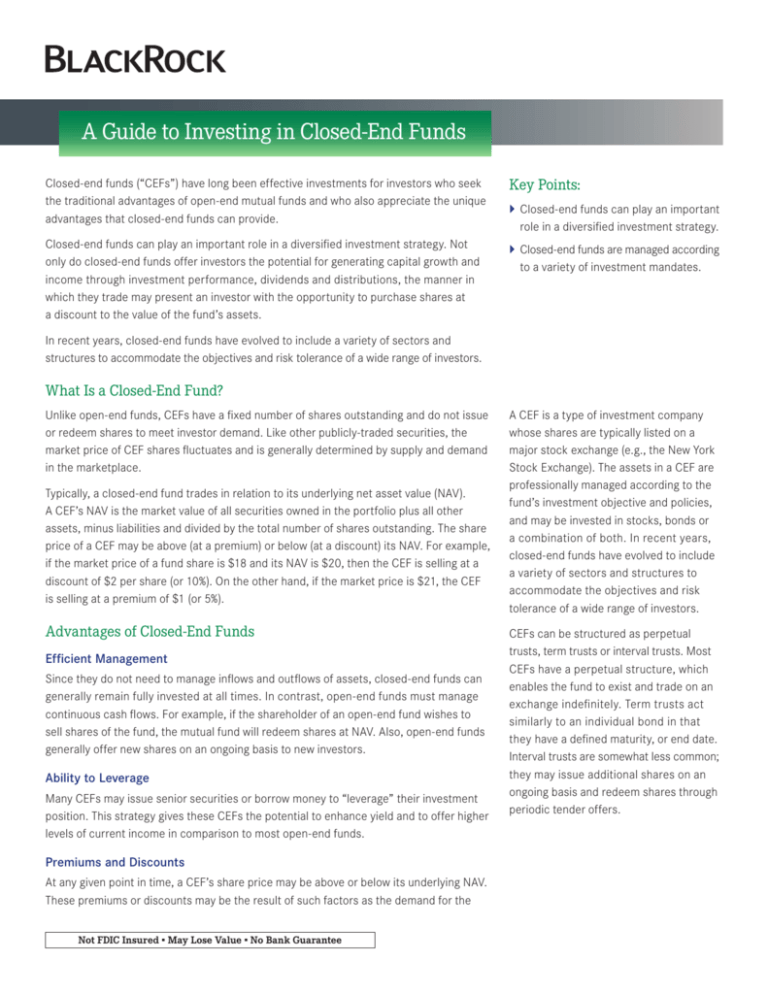
A Guide to Investing in Closed-End Funds
Closed-end funds (“CEFs”) have long been effective investments for investors who seek
the traditional advantages of open-end mutual funds and who also appreciate the unique
advantages that closed-end funds can provide.
Key Points:
Closed-end funds can play an important role in a diversified investment strategy. Not
only do closed-end funds offer investors the potential for generating capital growth and
income through investment performance, dividends and distributions, the manner in
which they trade may present an investor with the opportunity to purchase shares at
a discount to the value of the fund’s assets.
}Closed-end funds are managed according
to a variety of investment mandates.
}Closed-end funds can play an important
role in a diversified investment strategy.
In recent years, closed-end funds have evolved to include a variety of sectors and
structures to accommodate the ­objectives and risk tolerance of a wide range of investors.
What Is a Closed-End Fund?
Unlike open-end funds, CEFs have a fixed number of shares outstanding and do not issue
or redeem shares to meet investor demand. Like other publicly-traded ­securities, the
market price of CEF shares fluctuates and is generally determined by supply and demand
in the marketplace.
Typically, a closed-end fund trades in relation to its underlying net asset value (NAV).
A CEF’s NAV is the market value of all securities owned in the portfolio plus all other
assets, minus liabilities and divided by the total number of shares outstanding. The share
price of a CEF may be above (at a premium) or below (at a discount) its NAV. For example,
if the market price of a fund share is $18 and its NAV is $20, then the CEF is selling at a
discount of $2 per share (or 10%). On the other hand, if the market price is $21, the CEF
is selling at a premium of $1 (or 5%).
Advantages of Closed-End Funds
Efficient Management
Since they do not need to manage inflows and outflows of assets, closed-end funds can
generally remain fully invested at all times. In contrast, open-end funds must manage
continuous cash flows. For example, if the shareholder of an open-end fund wishes to
sell shares of the fund, the mutual fund will redeem shares at NAV. Also, open-end funds
generally offer new shares on an ongoing basis to new investors.
Ability to Leverage
Many CEFs may issue senior securities or borrow money to “leverage” their investment
position. This strategy gives these CEFs the potential to enhance yield and to offer higher
levels of current income in comparison to most open-end funds.
Premiums and Discounts
At any given point in time, a CEF’s share price may be above or below its underlying NAV.
These premiums or discounts may be the result of such factors as the demand for the
Not FDIC Insured • May Lose Value • No Bank Guarantee
A CEF is a type of investment company
whose shares are typically listed on a
major stock exchange (e.g., the New York
Stock Exchange). The assets in a CEF are
professionally managed according to the
fund’s investment objective and policies,
and may be invested in stocks, bonds or
a ­combination of both. In recent years,
closed-end funds have evolved to include
a variety of sectors and structures to
accommodate the objectives and risk
tolerance of a wide range of investors.
CEFs can be structured as perpetual
trusts, term trusts or interval trusts. Most
CEFs have a perpetual structure, which
enables the fund to exist and trade on an
exchange indefinitely. Term trusts act
similarly to an individual bond in that
they have a defined maturity, or end date.
Interval trusts are somewhat less common;
they may issue additional shares on an
ongoing basis and redeem shares through
periodic tender offers.
yield being offered, relative historical performance, number of
funds in a respective peer group, credit quality of the portfolio
and/or investor perception or confidence in the fund’s manager.
It may be advantageous to purchase a fund when it is trading at
a discount to its NAV, as more than a dollar of net assets goes to
work for every dollar invested. Therefore, the yield on the stock
price will be higher than that on the net asset value of the portfolio.
As a discount begins to narrow, investors will also have greater
potential for capital appreciation. Of course there is no assurance
that the discount will narrow.
Exchange-Traded Liquidity
CEFs are typically listed on a major exchange such as the New
York Stock Exchange or the American Stock Exchange. A listing
provides the benefit of liquidity and the convenience of being able
to track an investment—via select newspapers and electronic
services—using its assigned ticker symbol. With closed-end funds,
an investor can purchase shares throughout the trading day at the
current market price, as opposed to once a day at the close of
business at NAV.
Attractive Income
Most CEFs distribute income on a monthly or quarterly basis.
Investors generally have the option of receiving ­distributions
in cash or having their dividends r­ einvested. By automatically
reinvesting dividends, investors purchase additional fund shares
on an ongoing basis, and have the advantage of compounding
their returns as invested capital. Over time, this has the potential
to lead to higher future returns.
Taxable U.S. Bonds
These CEFs focus on high-quality instruments, such as Treasuries,
government agencies and investment-grade corporate bonds, all
of which generate interest income that is taxable by the federal
government. Others may add lower-grade high-yield bonds into
the portfolio, which provide attractive rates of return at somewhat
higher levels of risk.
Municipal Bond
Municipal bond CEFs seek to pay income exempt from federal
income taxes (and, in some cases, also exempt from state or local
income taxes). These CEFs invest in bonds issued by state and local
governments and agencies. Professional ­managers monitor bond
ratings and credit quality, and usually seek to broadly diversify the
portfolio and avoid adverse events or defaults that might impact a
given sector, region or issuer. Many municipal bond closed-end
funds make use of leverage to enhance their return potential.
Sector and Specialty
These CEFs focus on stocks of a particular industry such as
banking, media, natural resources or health care, or on ­specialized
securities such as preferred stocks or convertible securities. They
can offer a way for investors to participate in the fortunes of an
economic sector, industry group or specialized security, while
reducing risk through diversification.
Global and International Equity
Types of Closed-End Funds
CEFs offer counterparts to the mutual funds that build globally
diversified portfolios of stocks or fixed income instruments. CEFs
that diversify portfolio assets among U.S. and foreign securities
are called “global,” while those that focus on non-U.S. investments
only are considered “international.” Some CEFs specialize in
emerging market securities, which can be highly volatile and
somewhat illiquid under adverse market conditions. Since CEFs are
not forced to sell assets from their portfolios to meet redemptions,
they may offer special advantages over open-end funds in such
markets, as well as access to markets that are difficult for open-end
funds to invest in given their liquidity considerations.
Diversified Equity
Single-Country
Diversified equity CEFs invest in common and preferred stocks
of domestic and international companies, and may emphasize
current income, capital appreciation or some combination of
income and capital appreciation. These CEFs may build portfolios
that consist of stocks issued by a broad range of companies,
diversified across industries, geographies and economic sectors,
or they can focus on specific investment styles such as large cap,
small cap, growth or value.
There are single-country funds specializing in stocks traded in
countries such as Korea, India, Mexico, Spain and Germany. The
closed-end fund structure gives the portfolio manager the freedom
to devise a long-term strategy and hold positions through periodic
declines, which may impact stocks in these markets. The goal of
most single-country funds is to produce superior capital appreciation
over holding periods of ­several years.
Reduced Expenses
As a CEF trades on an exchange with a fixed number of shares
there are no ongoing costs associated with ­distributing those
shares. Because of this, CEFs may have lower expense ratios than
open-end funds. As time goes on, a lower fee structure can help
benefit investment performance.
Floating Rate
The floating rate CEF is a timely alternative for investors seeking the
potential for high current income. These CEFs have underlying
securities with rates that are structured to reset as interest rates
move up or down so that investors can take advantage of these
movements. These funds may offer investors a “hedge” against
rising interest rates.
Important Considerations
Leveraging
As a means of enhancing return, many fixed income closed-end
funds may issue senior securities or borrow money to “leverage”
their investment position. There is no assurance that a fund’s
leveraging strategy will be successful. Once a portfolio is leveraged,
the net asset value and market value of the common shares will
be more volatile. While a common investment practice by many
CEF managers, leverage cannot assure a higher yield or return to
the holders of the common shares.
Covered Call Writing
A CEF employs a covered call strategy to enhance yield potential.
A covered call option written on a security grants the buyer of the
option the right to buy stock that the option writer owns at the option
strike price. In writing covered calls, the option writer gives up
appreciation potential above the strike price of the option. However,
the option writer receives a premium for giving up that appreciation
potential. Since the option writer already owns the underlying stock,
the shares or cash equivalent can be delivered from the writer’s
account. Regardless of whether the option is exercised or it expires,
the writer of the option keeps the premium paid by the option buyer.
As a CEF writes covered calls over more of its portfolio in order to
enhance distributions to shareholders, its ability to benefit from
capital appreciation becomes more limited.
Dividend Adjustments
Investors considering CEFs should be aware that dividends may
be adjusted up or down depending on market conditions and other
factors. A decrease in the dividend may occur when individual
portfolio securities mature in a period of declining interest rates,
causing reinvestment at lower rates. Conversely, a dividend may
be increased when individual portfolio securities mature in a
period of rising interest rates and reinvestment is at higher rates.
Callable bonds held in a portfolio can also impact dividends.
Bonds can be prepaid or called away by their issuers in advance
of their stated maturity date. This often happens when interest
rates are lower than they were when the bonds were issued.
If a bond is called during a period of declining interest rates,
reinvestment will necessarily occur at lower interest rates.
A CEF’s leveraging strategy also needs to be considered for its
potential impact on dividends. When a CEF’s borrowing costs are
higher than expected, exceeding earnings on related assets, or
when the spread between borrowing costs and the amount
reinvested narrows, the fund’s dividend may come under pressure.
Conversely, a CEF’s dividend may benefit when the fund’s cost of
borrowing decreases.
Managed Distributions
A managed distribution policy is an investment company’s
commitment to common shareholders to provide a predictable,
but not assured, level of cash flow. This distribution policy typically
takes the form of a regular fixed cash payment or a payment
based on a percentage of a CEF’s assets, generally on a monthly
or quarterly basis.
Duration
Duration is an important concept to consider when investing in
CEFs with exposure to bonds. Duration is a basic measure of
interest rate risk. It can help predict the likely change in the price
of a bond given a change in interest rates. For example, the longer
a bond’s maturity, the longer its duration because it takes more
time to receive full payment. The shorter a bond’s maturity, the
shorter its duration because it takes less time to receive full
payment. In a closed-end fund, duration allows for the effective
comparison of bonds with different maturities and coupon rates.
Alternative Minimum Tax (AMT)
Investors in tax-exempt CEFs need to be aware that if they are
otherwise subject to AMT, income from these funds may not
always be tax-exempt. Investors should consult their tax advisors
if they are subject to AMT.
Market Risk
As with any publicly traded security, the price of a fund’s shares
will fluctuate with market conditions and other factors. If shares
are sold, the price received may be more or less than the original
investment. CEF shares are designed for long-term investors and
should not be treated as trading vehicles.
Interest Rate Risk
Generally, bonds will decrease in value when interest rates rise
and increase in value when interest rates decline. This means that
the net asset value of a fixed income CEF will fluctuate with interest
rate changes and the corresponding changes in the value of a
fund’s bond holdings.
Credit Risk
About BlackRock
Lower-rated bonds carry a greater degree of risk that the issuer will lose its ability to make
interest and principal payments. This could impact a fund’s net asset value of dividends.
Since our founding more than 20 years
ago, BlackRock® has held true to the core
principles of putting investors’ interests
first, and striving to deliver the investment
performance they expect. We believe the
combination of our scale, global market
insight and leading-edge risk management
capabilities positions us to deliver
consistent long-term investment results
with fewer surprises.
Measures of Performance
To judge the performance of a closed-end fund, an investor should not simply look at
yield alone. The best measure of performance in a perpetual closed-end fund is total
return—that is, the changes in a fund’s actual market price plus all fund distributions
over a given period.
Take the Time to Understand Your Potential Investment
CEFs are managed according to a variety of investment mandates. For example, they
are available as diversified equity funds, taxable U.S. bond funds, municipal bond funds,
sector and specialty funds, global and international equity funds, single-country equity
funds and floating rate funds.
Before investing in a CEF, investors need to understand and evaluate some of the special
considerations and risks associated with CEFs.
It is important to note that a fund’s use of derivatives, such as covered call options, may
reduce a CEF’s returns and/or increase volatility.
BlackRock offers investors a full spectrum
of investment solutions — each backed by
the standards of excellence that define our
firm’s culture — including mutual funds,
closed-end funds, exchange traded funds,
separately managed accounts, money
market funds, 529 college savings plans,
alternative investments and variable
insurance funds.
This guide is not to be construed as a solicitation or an offer to buy or sell securities. The views contained herein are those of BlackRock and
are based on information obtained by BlackRock from sources that are believed to be reliable. This material should not be considered tax,
investment, legal or other professional advice. The information herein is not necessarily all-inclusive and is not guaranteed as to accuracy.
Reliance upon information in this guide is at the sole discretion of the reader. Past performance does not guarantee future results. No
assurance can be given that a fund will achieve its investment objective. The investment return and ­principal value of an investment will
fluctuate, so that an investor’s shares, when redeemed or sold, may be worth more or less than their original cost.
BlackRock is a registered trademark of BlackRock, Inc. All other trademarks are the property of their respective owners.
FOR MORE INFORMATION: www.blackrock.com
Prepared by BlackRock Investments, LLC, member FINRA.
©2010 BlackRock, Inc. All Rights Reserved.
AC5168-1110 / CEF-INVGUIDE-1110

